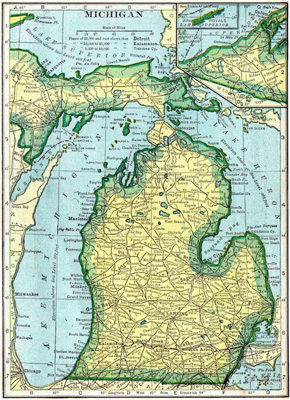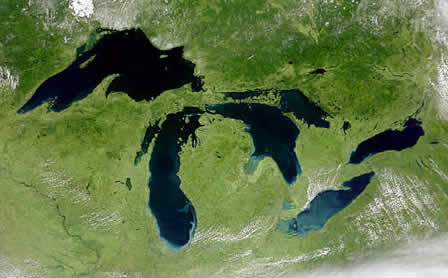—Jada Pinkett Smith
—Dr. Grace Lee Boggs, philosopher and Detroit community organizer
—ECO Girl Parent
The Ecoregion
Join us in exploring the names, habits, and habitats of our Great Lakes plant and animal neighbors and see what the Eco Girls are learning about ecology, botany, and environment through the lenses of diverse cultural understandings.

Photo credit: accessgenealogy.com
In this section, we want to share some interesting facts, ideas, and stories about our ecoregion here in Michigan and the Great Lakes. (Whenever we can, we’ll add images, sounds and activities too.) An ecoregion is a huge regional ecosystem that has unique geography, soil types and climate which support particular kinds of plants and animals. Within each ecoregion there are multiple smaller ecosystems such as different types of forests, lakes, rivers and wetlands. An ecosystem is a three-dimensional chunk of space that includes air, water, soil, plants and animals. It is kind of like a sandwich where the air and earth/water makeup the bread, and all the living organisms, or biota, are the meat, veggies, peanut butter or jelly in the middle. Every ecoregion is unique and contributes to our own individual sense of who we are and where we belong.
Throughout this section on our ecoregion in southern Michigan, we will be highlighting how Anishinaabe people (Native Americans also known as Chippewa/Ojibwe, Ottawa/Odawa, and Potawatomi) view the natural world of the Great Lakes region. Because the Anishinaabeg were among the first people in the Great Lakes area, they have a long memory of the land and its plant and animal inhabitants. Native American knowledge of southern Michigan's ecoregion can teach us all valuable ideas and perspectives.
Even for those Eco Girls who are themselves Anishinaabeg or are from other Native Great Lakes nations, there is a lot to learn and be reminded of about indigenous knowledge of the region. For instance, in the Anishinaabe language, known as Anishinaabemowin, there is no specific word for “nature.” Plants, animals, and people are all part of one system, recognized as being inseparable and interdependent (dependent on one another). Here is a quotation from the book, Sacred Water: Water for Life that explains this idea: "Kinship extends far beyond the human family and makes for an appreciation of the world that is cooperative caring and interconnected" (p.34). And here is a story that I heard from an Anishinaabe language teacher that makes the same point:
It is said that animals were put in charge of hiding “wisdom” in the particular places that they lived. This meant that people had to know the animals very well — their habits and habitats — in order to find and access wisdom.
Beliefs such as this one, as well as specific knowledge about plants, animals and places, have been cultivated by Native people over several thousands of years living in one ecoregion. Knowledge is passed down from one generation to the next. It continually accumulates and slowly changes across generations as people add their own experiences and observations to what their parents taught them. We are all part of the natural world, and we can learn fascinating and important things by paying close attention to the animals, plants, trees, water, and land around us, and by asking questions and listening to our elders.

Photo credit: coastwatch.msu.edu
Where are we and what makes this place so special? Have you ever looked at Michigan on a map? You will notice that our state is shaped like a mitten and is made of two peninsulas. Each peninsula is surrounded on all but one side by water. So what?
This isn’t just any old kind of water, this is fresh water, the very kind of water that all living things depend on, including us humans! Most of the earth’s water is salt water in the oceans — less than 1% of Earth’s water is fresh water available for human use. But it just so happens that the Great Lakes store one of the largest supplies of fresh water on the planet, with 6 quadrillion gallons (that’s a lot!) of fresh water. This makes up 1/5 of the world’s fresh surface water and 95% of the fresh water supply in the United States. This means that the mitten-shaped state is a very special place in which to live. It also means that those of us who live in Michigan and around the Great Lakes have a special and important responsibility to take care of the water in these lakes.
ECO Girls know that to take care of the water means that we also take care of ourselves and each other, and of all the natural ecosystems around the Great Lakes. We understand that the health of the lakes depends on the health of the surrounding woodland, prairie, and wetland ecosystems. It’s all connected!
The Great Lakes provide homes to many species of plants and animals. When we bring together the first letters of the names of all five Great Lakes, it actually spells the word HOMES (Huron, Ontario, Michigan, Erie, and Superior). This acronym can help remind us not only of the names of each of the Great Lakes, but of the importance of taking care of our very special home on the planet.




